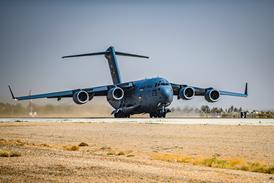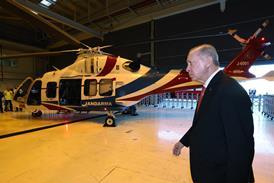As the tenth Dubai air show gets under way, the show’s organisers look back on how the exhibition has blossomed in its 21-year history. Alan Peaford reports
Dubai Air Show organisers F&E, has reason to celebrate today as the tenth edition of what has been described as the world’s favourite air show gets underway.
The statistics are already impressive, says Alison Weller, F&E’s director of aerospace. “At the first show we had 200 exhibitors compared to today’s 850. There were 25 aircraft compared to 140 now and we squeezed into 7,000sq m.” This year’s show is a complete sell-out, so F&E is still squeezing in the exhibitors, though there is now 35,000sq m of floor space. And Weller has plans to make the show even bigger.
But for the tragedy of the 1975 Lebanese Civil War, the Dubai air show might never have happened. The war effectively knocked out one of the Middle East’s most cosmopolitan, business-friendly hubs. Hundreds of international companies had to find a new base for their operations in the region.
Fairs & Exhibitions (F&E), which had previously worked all over the world, had just decided to make the Middle East its niche market and had been planning to locate its Middle East operations in the Lebanese capital, Beirut. Instead, it looked south for a suitable base and studied both Bahrain and Dubai before settling on the latter.
F&E decided in the mid-1980s to focus its activities on the transport sector, and it was obvious that aviation would be the most important part of that sector. This led it to start the Arab Air – Middle East Air Transport and Airport Equipment show at the Dubai World Trade Centre exhibition halls in 1986. With no runway, only a couple of helicopters could act as outdoor exhibits. But it was a start.
From the outset, Dubai’s government took an interest in this aviation showcase, although initially its involvement was fairly light. “We had the acknowledgement of the Dubai government,” recalls Virginia Kern, F&E’s chairman. “Today’s ruler Sheikh Mohammed bin Rashid al-Maktoum was there – he was minister of defence in those days – and Mohi din Binhendi, the director of civil aviation. It was a purely civil aviation event, but they came along because it was their sector.”
The event was sufficiently successful to be repeated in 1988 – and this time it was supported by both the directorate of civil aviation and Dubai international airport. Sheikh Mohammed again showed his interest. “He came to open the show,” recalled Virginia, “and said ‘It’s fantastic, but it’s only civil aviation.’ Previously we had been prevented from including any military aviation because of the Iran-Iraq War, which was raging at the time, but he said he wanted something that would emulate Farnborough, Paris or Singapore.”
The time was ripe for a move to a site that would allow the show to expand and display a greater range of aircraft. The result was the first Dubai Air Show in 1989 and the location was the cargo village on Dubai’s international airport.
F&E worked with a team from contractor Balfour Beattie, who were already carrying out work on the airport. A team of engineers was seconded to the project to create an exhibition space for the event – the conversion of two hangars formerly used by Emirates airlines.
This was at the western end of the airport, where the cargo village was established, and was to serve as the location for the first five air shows. It meant that space was now available for aircraft to fly in and to be displayed in a static park, greatly enhancing the show’s attraction to exhibitors and visitors alike.
Given the scale of the proposed newcomer to the show circuit, it was remarkable that “all the organising happened out of a 13m Portakabin,” Kern adds. “It contained our offices, reception and was the location for everyone to collect their tickets.” With new facilities to oversee, the learning curve was steep. One aspect of that curve was positioning an airshow in the middle of an operational international airport, which required considerable co-operation with the airport authorities and Dubai’s Directorate of Civil Aviation.
“Because Dubai has always had this huge ambition to be the biggest and the best, there’s always been a great deal of co-operation and we’ve been able to overcome what would have been barriers in other parts of the world,” says Kern.
This enthusiasm from the Dubai government was particularly helpful. Both F&E and the government believed that the development of the aviation industry and the maturing of the Middle East market meant Dubai could stage a show of international proportions covering both the civil and military markets.
A critical factor was that co-operation flowed from the very top. “The support of both Sheikh Mohammed bin Rashid al-Maktoum and Sheikh Ahmed bin Saeed Al Maktoum, president of the department of civil aviation, obviously opened a lot of doors,” says Kern. The attitude was one of ‘This has to get done, so let’s just get on and do it.’
Throughout the years the show has continued to grow. The November 1999 show – actually called Dubai 2000 to mark the approaching millennium – brought the next major development.
“Sheikh Mohammed’s ambition is that it should become the world’s number one show,”. “He has always said ‘What do we have to do to encourage this growth?’,”says Kern Dubai provided that encouragement in a major way when its government gave the go-ahead for permanent facilities and the show moved to the current Airport Expo.
With several wars to contend with in the region, and the tragedy of 9/11 just weeks before the 2001 show, many would have predicted failure. But every year the downsides have been beaten by the positive changes, investment and a commitment to do business rather than just provide a spectacle.
In 2009 another new showground will open giving more space. The Dubai story continues to gather pace - who knows how big this thing can get!
Back to the rest of Dubai 2007 show news, blogs, and pictures
Source: Flight Daily News




















